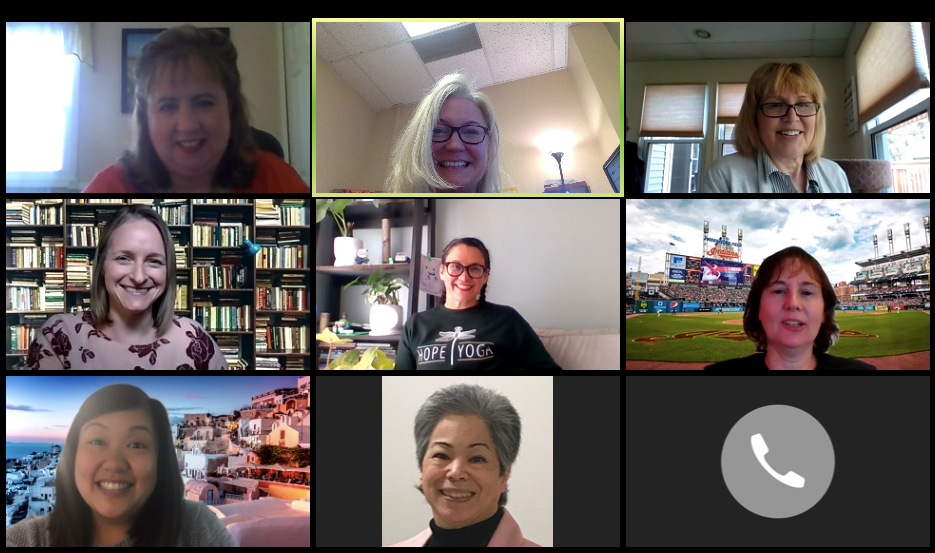The Case Western Reserve University COVID-19 Task Force, led by Jonathan Karn and Rafick Pierre Sekaly, has made great progress over the past seven weeks. Bringing forward the best ideas and expertise from CWRU and its affiliates, the task force is producing energetic and thoughtful collaboration and support for top projects, preparing laboratories to analyze live SARS CoV-2 samples, readying spaces and policies for physically-distant working, and prioritizing the use of potentially scarce resources—all in an effort to attack the pandemic from many sides.
COVID-19 Admin Warriors—Developing the Plan and Building the Infrastructure
COVID-19 Task Force Admin Warriors (left to right) top: Carol Rice, Erin Fogarty, Kriss Basso; middle: Kathy Miller, Alicia DePlachett, Joan Schenkel; bottom: Pearline Cartwright, Brinn Omabegho
Fighting this new and complex virus isn’t possible without a plan—or, in this case, many plans. Led by Erin Fogarty and Joan Schenkel, the task force’s outstanding administrative support (also known as the COVID-19 Admin Warriors) has developed the infrastructure, databases and tools to organize and mobilize the research forces. The Warriors include: Kristine Basso, Pearline Cartwright, Kathy Miller, Brinn Omabegho, Carol Rice and Mike Warfe (UTech, Research Computing)
Coordinated and implemented via the task force’s executive committee, steering committee and five working groups, the researchers and COVID-19 Admin Warriors have created the infrastructure and developed working plans and methods, such as:
- Supporting the researchers who are connecting individuals and research resources—remarkable synergies are underway
- Creating and maintaining the expansive database, CLECOVID.case.edu, in tandem with our UTech partners: a one-stop access point facilitates organizing and sharing data, research interests, samples, research space, SARS CoV-2 funding opportunities (federal and non-federal), detailed infrastructure description, contact names and organizational charts
- Adding SARS CoV-2 research and safety protocols to existing labs: repurpose research rules related to live virus research; acquire needed equipment and supplies; secure environmental security and lab availability, including adequate space for research in an environment requiring social distancing
- Achieving Institutional Review Board (IRB) approval for specimen collection
- Guiding prioritization of receipt and distribution of samples
Researchers and Proposals
To date, 268 researchers from across the campus and our affiliates answered the call for SARS CoV-2 Task Force investigators, collaborating on cutting-edge research, innovation and funding opportunities.
Over a very short period, the task force developed more than 46 research proposals relevant to diagnosis, treatment, biology, and control of coronavirus. The task force co-chairs selected 12 proposals for review, in response to a request from the university to articulate proposals that may be eligible for immediate foundation relations funding. Additionally, more than 29 proposals were submitted to federal sponsors, and 11 were submitted to private and/or industry sponsors.
Investigators in very different areas have joined together to work for the benefit of the community. The public health contingent, led by Heidi Gullett and Kurt Stange, sought out immunologists to obtain the best tests for anti-COVID antibodies. Their goals are to investigate infection in vulnerable groups such as pregnant women and to also identify those who are truly convalescing from the disease and may have antibodies to donate for therapeutic purposes for those who are gravely ill.
To create a unified predictive model for our region, the School of Medicine’s hospital affiliates agreed to share data and modeling assumptions, and to work with faculty member Johnnie Rose and his team, including members of the Department of Applied Mathematics at CWRU. Recognizing the COVID-19 incubation period, these models will improve accuracy for those assessing the timing of the end of restrictions and decide when in-person classes and clinical rotations can resume.


